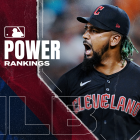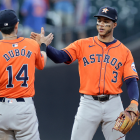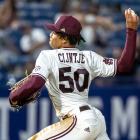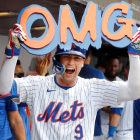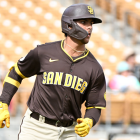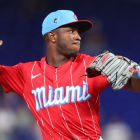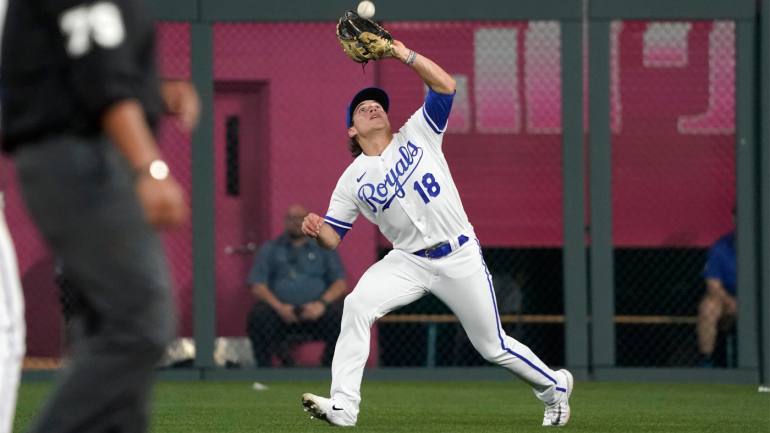
The 2023 MLB regular season is roughly two weeks old and, to be completely honest with you, this is the worst time of year to analyze baseball. The sample sizes are so small and it is damn near impossible to differentiate what's meaningful from what's nothing more than baseball being weird. But, we soldier on.
Our bi-weekly series breaking down various trends across the league begins Wednesday with one young pitcher's new pitch, a young hitter's adjustment at the plate, and one team's unique outfield shift. Let's get to it.
Gilbert's new splitter
Last year, in his first full big league season, Mariners righty Logan Gilbert broke out as one of the game's top starters, throwing 185 2/3 innings with a 3.20 ERA. Once adjusted for ballpark and the league's run-scoring environment, Gilbert was 17% better than the average pitcher. Yet, as good as he was, the under-the-hood numbers didn't exactly jump off the page:
| Strikeout rate | Walk rate | HR rate | Swinging strike rate | Ground ball rate | Avg exit velocity | |
|---|---|---|---|---|---|---|
2022 Gilbert | 22.7% | 6.4% | 0.92 | 10.8% | 36.7% | 91.0 mph |
MLB average | 22.4% | 8.2% | 1.09 | 11.2% | 42.9% | 88.6 mph |
Gilbert limited walks and generally kept the ball in the park, but he didn't rack up strikeouts or generate a lot of weak contact on the ground. That isn't to say he'll never do those things -- first-year starters are rarely fully formed and playing to their full potential -- just that he didn't do those things in his first full big-league season. Regardless, Gilbert had a fine 2022 campaign.
Typically a fastball/slider/curveball/sometimes changeup pitcher, Gilbert reported to spring training this season with a new weapon: a splitter. He worked on it in the Cactus League and has brought it into the regular season. Through two starts Gilbert has thrown the splitter 16 times and gotten six misses on 12 swings, a stellar 50% whiff rate in an admittedly small sample.
"I've always tried to throw a changeup and just kind of struggled with it. It just wasn't natural for me," Gilbert told Seattle Sports in spring training. "So we just tried to find basically a variation -- a splitter -- that I can throw like a fastball and should be able to throw it to hopefully lefties and righties just as well."
In the limited sample the numbers on Gilbert's splitter are good. It's top 10 in the league in vertical movement (on par with Nathan Eovaldi's and Taijuan Walker's splitters) and bottom five spin rate (on par with Shohei Ohtani's splitter). With splitters and changeups, low spin is preferred because it creates tumbling action downward, and Gilbert gets low spin on the pitch.
Splitters are a chase pitch. They are designed to finish below the zone to get swings and misses or weak contract when the hitter hits the top of the ball. Last year Gilbert ran a 27.6% chase rate, a tick worse than the 29.1% league average. This year his chase rate sits at 40.5% through two starts. The 12.9 percentage point year-over-year increase is far and away the highest in baseball.
"He's going to miss a ton of bats," Mariners pitching coach Pete Woodworth told Seattle Sports. "Right, left, he's not going to have to rely on a breaking ball to get some swing and misses or lean on his fastball to punch guys out at the top. It's another dimension. If you have to cover his fastball at the top, anything moving down that looks like that? That's what it was built for. That's the idea behind creating this pitch."
"I'm working on a new pitch" is one of those spring training tropes like "I'm in the best shape of my life" and "we want to run the bases more aggressively." Lots of guys try stuff in March and abandon it in April. Gilbert's splitter appears to be the real deal though. He was very good last year, but there is always room for improvement, and this new splitter could take Gilbert to the next level.
Marsh's adjustment leads to more contact
The first two weeks of the season have not gone especially well for the reigning National League champion Phillies. They have been hit hard by injuries, so much so that the guys who replaced the injured guys are now getting hurt, and co-aces Aaron Nola and Zack Wheeler have combined to allow 19 runs in 25 innings. It's been tough sledding.
One bright spot: Brandon Marsh. The 25-year-old center fielder is hitting .407/.467/.926 in the early going, and he's struck out only six times in 30 plate appearances (20.0%). For a player who ran a 31.4% strikeout rate last season, that's a great sign early in the season. Marsh's contact rates are improved as well:
| 2022 | 2023 | Change | |
|---|---|---|---|
Swinging strike rate | 13.0% | 5.8% | -7.2% (second largest in MLB) |
In-zone contact rate | 81.8% | 97.3% | +15.5% (largest in MLB) |
With the caveat that it has only been two weeks, Marsh's improved contact ability is notable because it dates back to late last season, and because he's made a few mechanical adjustments. The Phillies acquired Marsh in a deadline deal with the Angels last summer, at which point hitting coach Kevin Long went to work. From The Athletic last October:
"He was always late. He was never on time," Long said. "So I looked up what he did against fastballs. He hadn't pulled a right-handed fastball all year. It just didn't make sense to me. Like, this guy hadn't pulled a right-handed fastball?"
...
"I just tried to simplify it all," Marsh said. "Take a lot of the distractions, a lot of the excess stuff out of it. And really just putting the bat on the ball. Taking a lot of the moving parts out of there. I like the change."
They don't put hitting coaches in the Hall of Fame but Long's resume is as good as anyone's. He's taken four different offenses to the World Series (2009 Yankees, 2015 Mets, 2019 Nationals, 2022 Phillies) and has a track record of helping contact hitters unlock power (most notably Robinson Canó, Daniel Murphy, and Howie Kendrick). In Marsh's case, Long has to get him to make more contact. They can work on his power stroke later.
Here's what Marsh looked like with the Angels in the days leading up to the trade last year, and what Marsh looks like now:
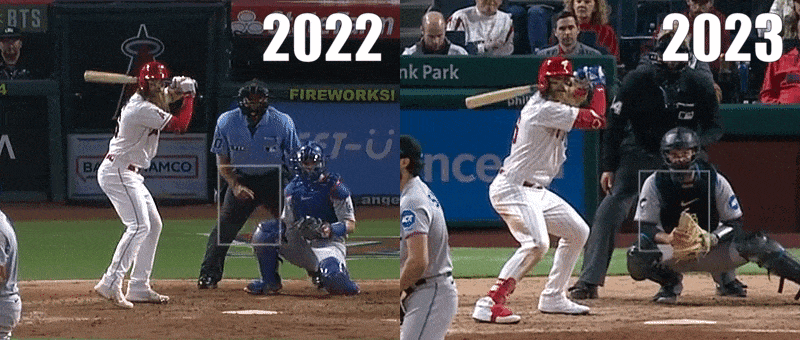
All the change is in the lower half. Marsh is more open and has a wider base now, plus he's eliminated the toe tap. Now it's just a small little leg kick and everything is simplified. Marsh incorporated these changes soon after the trade and his September numbers (11.7% swinging strikes and 84.8% in-zone contact) were better than April through August (13.3% and 82.0%, respectively).
I don't believe Marsh is suddenly a true talent 5.8% swinging strike rate and 97.3% in-zone contact rate hitter because very few hitters make that much contact. That's José Ramírez territory. But the mechanical changes are a tangible reason to believe in improved contact ability. Marsh has a great glove and will likely always be a defense-first player, but with a little more contact and more offense in general, there's All-Star potential here.
"I devised a game plan on what I was going to do with his swing and the mechanics of his swing," Long told The Athletic. "I always start by getting guys closer to the hitting position than further away. So we spread him out. We got him into his legs. It worked."
Royals toying with two-man outfield 'shift'
As part of the league's sweeping rule changes this year, MLB has banned extreme infield shifts. There must be two infielders on each side of second base when the pitch is thrown, and they must have both feet on the dirt (or infield grass). No more putting the shortstop in shallow right field. The shift is gone! Right? Well, ask Corey Seager, one of the most shifted hitters in the game:
Earlier this week Seager fell victim to the new two-man outfield shift, something several teams toyed with in spring training but only the Royals have used in regular season games thus far. Kansas City occasionally stations its right fielder in shallow right, mimicking the extreme infield shifts of the past, while putting their remaining two outfielders in left-center and right-center.
"Everybody noticed it. I don't think it's been deployed all that often across the league so far this year," Giants manager Gabe Kapler told NBC Sports Bay Area after hosting the Royals this past weekend. "I think part of it probably has to do with the short right field in our ballpark and feeling like they can cover a lot of ground that way. Obviously they're taking risks leaving the middle of the field exposed, but I don't blame them for taking liberties like that. I think it makes some sense."
The Royals have only used the two-man outfield shift against extreme pull hitters like Seager and Joey Gallo. They're not doing it against every lefty hitter. Only the ones most likely to hit a ball into the shift, because if you get burned with this, it's extra bases, not a bunt single to where the third baseman should be. Here are some more numbers on Kansas City's two-man outfield shift:
This is the 2-OF configuration that the Royals are using https://t.co/lS97gpEt4T pic.twitter.com/cYISIa9Wnn
— Tangotiger (@tangotiger) April 9, 2023
Again, only the Royals are using the two-man outfield shift. Kansas City is not expected to contend, so they have more leeway to try new things without worrying about the standings. It remains to be seen whether they are pioneers or merely playing checkers while everyone else plays chess, but, if it works, it will catch on. You can be sure the rest of the league is paying attention.
"I think that's an interesting way to play it. I don't foresee it happening for a long time once teams get beat a few times," Giants outfielder Mike Yastrzemski told NBC Sports Bay Area after falling victim to the two-man outfield shift. Maybe he's right, but we all said that about extreme infield shifts when they first popped up. If the two-man outfield shift is a net positive, more teams will do it.














